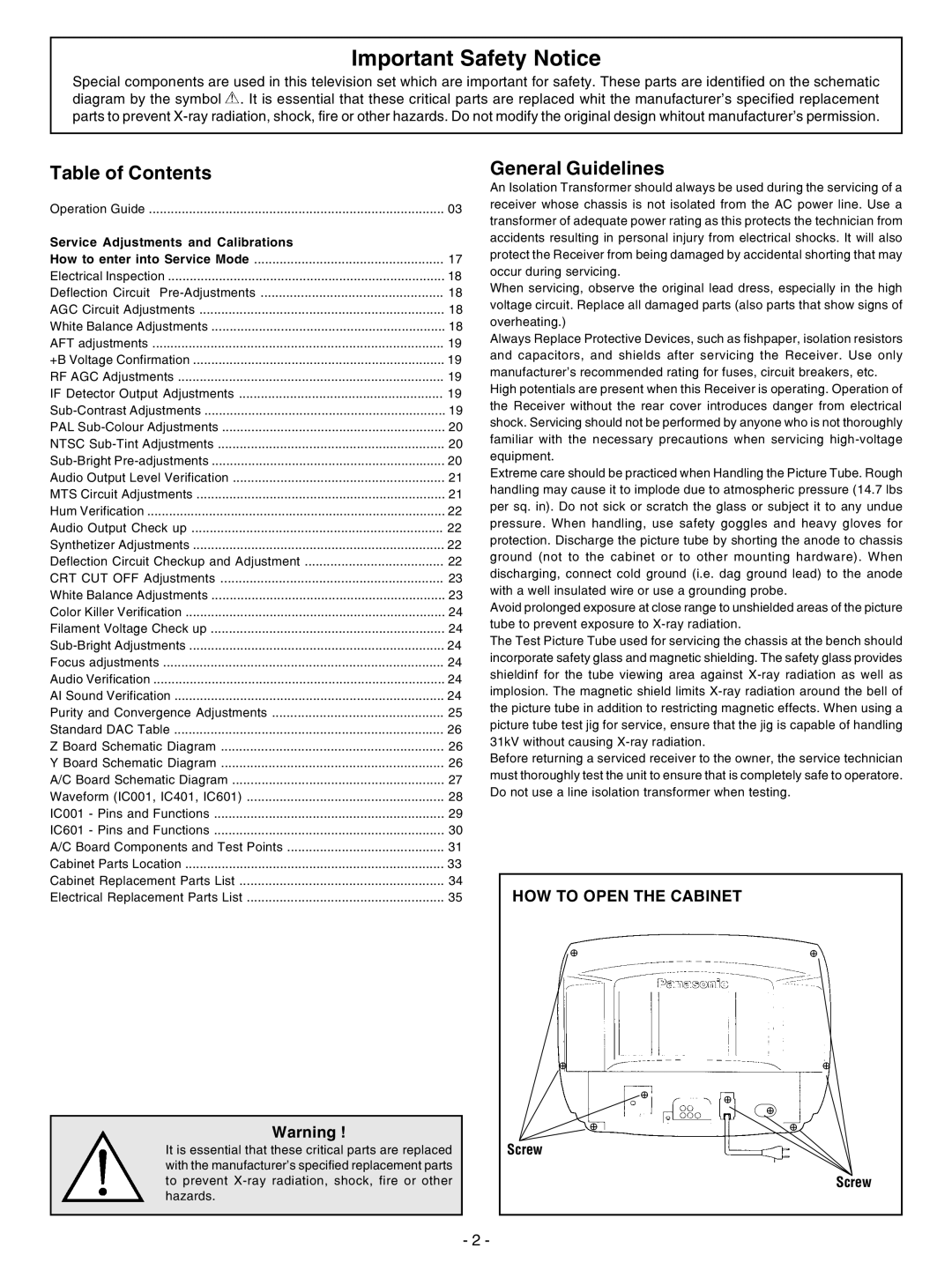
Important Safety Notice
Special components are used in this television set which are important for safety. These parts are identified on the schematic diagram by the symbol ![]() . It is essential that these critical parts are replaced whit the manufacturer’s specified replacement parts to prevent
. It is essential that these critical parts are replaced whit the manufacturer’s specified replacement parts to prevent
Table of Contents |
|
Operation Guide | 03 |
Service Adjustments and Calibrations |
|
How to enter into Service Mode | 17 |
Electrical Inspection | 18 |
Deflection Circuit | 18 |
AGC Circuit Adjustments | 18 |
White Balance Adjustments | 18 |
AFT adjustments | 19 |
+B Voltage Confirmation | 19 |
RF AGC Adjustments | 19 |
IF Detector Output Adjustments | 19 |
19 | |
PAL | 20 |
NTSC | 20 |
20 | |
Audio Output Level Verification | 21 |
MTS Circuit Adjustments | 21 |
Hum Verification | 22 |
Audio Output Check up | 22 |
Synthetizer Adjustments | 22 |
Deflection Circuit Checkup and Adjustment | 22 |
CRT CUT OFF Adjustments | 23 |
White Balance Adjustments | 23 |
Color Killer Verification | 24 |
Filament Voltage Check up | 24 |
24 | |
Focus adjustments | 24 |
Audio Verification | 24 |
AI Sound Verification | 24 |
Purity and Convergence Adjustments | 25 |
Standard DAC Table | 26 |
Z Board Schematic Diagram | 26 |
Y Board Schematic Diagram | 26 |
A/C Board Schematic Diagram | 27 |
Waveform (IC001, IC401, IC601) | 28 |
IC001 - Pins and Functions | 29 |
IC601 - Pins and Functions | 30 |
A/C Board Components and Test Points | 31 |
Cabinet Parts Location | 33 |
Cabinet Replacement Parts List | 34 |
Electrical Replacement Parts List | 35 |
General Guidelines
An Isolation Transformer should always be used during the servicing of a receiver whose chassis is not isolated from the AC power line. Use a transformer of adequate power rating as this protects the technician from accidents resulting in personal injury from electrical shocks. It will also protect the Receiver from being damaged by accidental shorting that may occur during servicing.
When servicing, observe the original lead dress, especially in the high voltage circuit. Replace all damaged parts (also parts that show signs of overheating.)
Always Replace Protective Devices, such as fishpaper, isolation resistors and capacitors, and shields after servicing the Receiver. Use only manufacturer’s recommended rating for fuses, circuit breakers, etc.
High potentials are present when this Receiver is operating. Operation of the Receiver without the rear cover introduces danger from electrical shock. Servicing should not be performed by anyone who is not thoroughly familiar with the necessary precautions when servicing
Extreme care should be practiced when Handling the Picture Tube. Rough handling may cause it to implode due to atmospheric pressure (14.7 lbs per sq. in). Do not sick or scratch the glass or subject it to any undue pressure. When handling, use safety goggles and heavy gloves for protection. Discharge the picture tube by shorting the anode to chassis ground (not to the cabinet or to other mounting hardware). When discharging, connect cold ground (i.e. dag ground lead) to the anode with a well insulated wire or use a grounding probe.
Avoid prolonged exposure at close range to unshielded areas of the picture tube to prevent exposure to
The Test Picture Tube used for servicing the chassis at the bench should incorporate safety glass and magnetic shielding. The safety glass provides shieldinf for the tube viewing area against
Before returning a serviced receiver to the owner, the service technician must thoroughly test the unit to ensure that is completely safe to operatore. Do not use a line isolation transformer when testing.
HOW TO OPEN THE CABINET
Warning !
It is essential that these critical parts are replaced with the manufacturer’s specified replacement parts to prevent
Screw
Screw
- 2 -
